IDF Soldiers, Officers Aided by Military Technology
The latest in military technology is helping soldiers and officers of the Israeli Defense forces perform their duties more efficiently and effectively than ever before.
A recent story on the IDF Blog takes an in-depth look at the new helmets Israeli Air force (IAF) pilots are wearing. These upgraded fighter helmets are absolutely state-of-the-art, and they are a far cry from the standard helmets pilots have worn in the past.
While these new helmets look impressive from the outside, it’s what’s inside these helmets that sets them apart from the rest. By now, we’ve all heard of and are familiar with the smart phone. Well, this is the smart helmet, and it’s a wearable piece of technology that helps the elite IAF pilots perform their sky missions with accuracy.
Classic fighter helmets have improved over the decades, to include features such as built-in radios, goggles, visors, oxygen supply, and electrical power. These helmets feature all that plus:
- an advanced projector system that displays real-time information vital to the pilot carrying out his or her mission; the inside of the visor acts as a screen; think of it as the real-world application of those CGI images of Tony Stark’s face inside the Iron Man mask
- a built-in, HD camera; it records all the action from takeoff to touchdown, which aids in pilot training and debriefing
In addition, each helmet is custom-tailored so that it fits the pilot perfectly. This cutting edge equipment is helping the pilots of the IAF perform with more precision than ever before.
On the ground, soldiers and commanders are using iPads as the latest tool in military intelligence. The ability to have real-time information at their disposal, as well as the ability to relay that information from unit to unit, means soldiers and commanders can stay in sync and maintain control in the field.
The iPads may be as critical a piece of equipment as any personal weaponry. For example, if a commander on the ground identifies a threat, he can share the location with a swipe of his finger. The intelligence is immediately relayed to a fighter pilot above, who can quickly neutralize the threat. Using a wireless network to relay information is a vast improvement over printed maps and radio communication.
Source: IDF Blog
Related: Global Test Market








